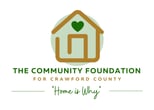Create a Legacy in Crawford County
Here is your opportunity to get your things in order and create a lasting legacy!
Talk to your tax attorney about all the ways to leave a planned gift including:
- Bequest: a provision made in a donor’s will, through which an organization receives cash and/or other assets at the time of the donor’s death.
- Charitable gift annuity: a legal contract between the donor and the organization, through which the donor exchanges cash, stocks, or other assets for an agreed-upon income for life.
- Charitable lead trust: established by a donor transferring assets to a trust that provides income to a nonprofit organization for a period of years. At the end of that period, the trust assets revert either to the donor (grantor) or to someone else the donor designates (non-grantor).
- Charitable remainder trust: used by donors to transfer assets to a trust, which then goes to the charitable organization after the death of the last beneficiary. The donor retains a fixed or variable income for life.
- Life estate contract: an agreement established by donors transferring a deed of real property to an organization while reserving for themselves and/or someone else the right to live on or use the property for life. Charitable deductions for life estate contracts are limited to properties that are either personal residences or farms.
- Life Insurance: a contract between an individual and an insurance company, providing a payment to the individual’s estate or to named beneficiaries (such as a spouse, children or grandchildren) at the individual’s death. Charities are also frequently named as beneficiary. By making a charity both the beneficiary and owner of the policy, a donor can make an immediate gift that will provide immediate or future funds for a charity or charities.
- Pooled income fund: a common trust to which many donors make contributions and retain for themselves a prorated share of the fund’s earnings each year. As each beneficiary dies, the value of the fund attributable to that death is severed and paid to the organization. It is similar to a mutual fund.
- Retirement funds (IRA, 401K): the IRA Rollover provision of the Pension Protection Act of 2006 allows a donor who has reached a defined age to exclude any IRA funds withdrawn and transferred to a charity from his or her income when filing a tax return for that year. The provision is applicable only to direct gifts of cash to charitable organizations (capped at $100,000 annually) from donors age 70-1/2 or older. Under the Protecting Americans From Tax Hikes Act of 2015 (“PATH”), which was passed by Congress and signed into law on Dec. 18, 2015, the IRA charitable rollover provision, which has shifted millions of dollars from IRAs into charity, has been made permanent, retroactive to Jan. 1, 2015.
Planned gifts, made during your lifetime, can be used to establish various fund types. What a wonderful way to see your charitable giving at work!





